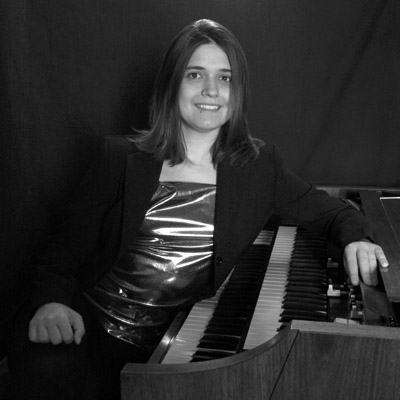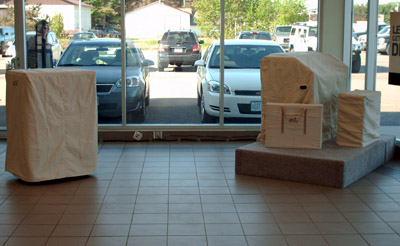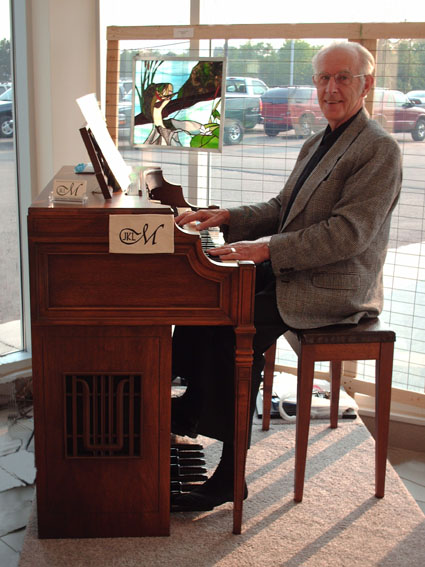This time I'm happy to present my good
friend from Montreal, Vanessa Rodrigues, as Organist of the Month. Even if
she is a friend, I'm still very much a fan, and I'm honoured to have seen
her work up-close. Her 2005 debut CD 'Soul Project' is a favourite of mine
and titles from it are referenced in the following. Oh, and V. if you read
this - thanks for making my good buddy from Fyn happy.
Here follows my virtual interview with Vanessa:
Personal
1. Name
Vanessa Rodrigues
2. Place(s) I call home
Montreal (grew up in Edmonton Alberta)
3. Style(s) I play
Jazz, funk, soul, Latin (piano), some classical, and anything else that
pays the bills ;)
4. Current CD/project
Hoping to release a live record made in Toronto in the spring of 2006. It
features my dream band: Chris Gale - sax, Davide DiRenzo - drums, and Mike
Rud - guitar. It's a lot more straight ahead than Soul Project, but it's
still pretty groovin'!
5. A person who inspired me to play the Hammond
Chester Thompson from the Tower of Power
Technical
6. Do you use a Leslie speaker?
Yes
If yes, is there anything you can share about how you use it?
I like to use chorale for the slow setting, rather than stopping the
rotors altogether - I enjoy listening to other people play stopped, but it
feels
really uncomfortable for me myself when I play.
7. Do you often play the bassline on the organ?
If yes, how do you do it?
Yes, I mostly play lines with the left hand and ghost/ double in the
pedals what my left hand is doing. I use pedals during ballads and chord
with the left hand.
8. Do you use the percussion effects in your organ?
If yes, what is your most used percussion setting?
Yes. I like the 3rd, soft volume, fast decay. I have been known to use
other sounds for fun though.I used 2nd with loud volume for Bemsha Swing,
and 50
points to anyone who figures out what setting I used at the end of Killa-Jewel
in da House during the drum & bass breakdown section.
9. Do you have a drawbar setting that is your own?
If yes, can we know it?
To be honest, I don't think I have any special settings, aside from the
one I mentioned in the last question. That one is more of an effect than
a sound I
would use to chord or solo or do anything functional.
...
Other than that my sounds are pretty much standard -- I think WHAT and
HOW a player plays is ultimately more important than the
drawbar/percussion/vibrato settings he/she uses, even though it's
interesting to know.
10. Is there anything that defines 'your sound'?
Well, from a technical organ setting perspective, I'm not sure ...
as I said, my settings are all pretty standard.
(Editor's note - good point, Vanessa, I will think
about moving this question to the 'artistic' section for next month).
When I listen in my head for an organ sound I want, I hear Dr. Lonnie
Smith. Even though he plays with the Leslie stopped sometimes, his sound
(and of course his playing) is closest to what I would LIKE my sound to
resemble. How close I come to that is another story I suppose ...

Vanessa with her pet A-100
From a playing standpoint I think what maybe makes me unique is the fact that my influences are all over the place, from MMW/Scofield to Oscar Peterson to Sonny Stitt, rather than coming straight out of the jazz organ history bag.
Artistic
11. A milestone in my Hammond organ playing career was:
My tour of Japan in 2005 with Sylvia Cuenca. Some of the tour was
just the two of us, and other concerts were organ summits with Japanese
musicians like Atsuko & Yutaka Hashimoto and Midori Ono. I had always
dreamed of going to Japan, and the whole time I was there I felt like that
was exactly why I was put on this earth! You can't beat that!
12. A great recording of Hammond music not of my own:
I have to pick just one??? check out Kjeld Lauritsen's record Hammond
Organ Jazz - he's one of Martin and my favorites, and more people should
know about him. He's the blackest white guy ever!
13. Do you compose music using the organ?
To be honest, not usually. I am more inclined to use the piano. When I
fire the organ up, it wants to be played NOW NOW NOW, so I can't sit there
and work things out slowly -- I have to PLAY! Maybe it's that roaring
motor or something ;)
It's easier for me to sit at the piano and fiddle with stuff because the
instrument isn't screaming at me to play it.
14. Did you use any special drawbar settings for the intro of 'Supabad
Stanley'?
I used all the principals (888808008), and I had the engineer add some
reverb during mixing to get a more churchy effect. Yes I stole the setting
from Billy
Preston :) you can see it in the photograph from the liner notes of Aretha
Franklin live at the Filmore West!
15. What is your website address?
http://www.vanessarodrigues.com/
====0000=======0000=======0000=======0000====
Vanessa's Soul Project CD can be purchased directly from her website or through the iTunes Music Store. Get a copy before your neighbour!
Feb 2007 - Introduction
Mar 2007 - Out and about
Apr 2007 - Tony Monaco
May 2007 - Wil Blades
Website updates
- Still working on the Tallboy Section, but I promise it will be up soon.
I have received some very interesting pictures and I have more in the
pipeline.
- When the Hammond Organ Company turned 50 in 1984, the company issued a
booklet with a golden cover. I have obtained a copy of this booklet and
scanned it for your viewing pleasure - look under Hammond > memorabilia.
- The Leslie manuals section has a new addition - the Japanese models 310
and 510 - thanks to Geoff for this!
- Another addition to the Leslie manuals section: Model 750
- Check out the T-series page in the Hammond section. There's a cool new
TTR-100 brochure.
During the months of April and May I was involved in making an organ rig ready for a live performance. The organ belongs to Canadian organist Maynard Schutt who has kindly permitted me to write about his organ and share pictures.
The organ
The organ in question is the newest in Mr. Schutt's collection and is a Hammond T-582C from 1973. It has been Mr. Schutt's gig organ since he obtained it in 2005.
The speaker
Although the T-500 series has a built-in Leslie speaker, the sound output of the console is only enough for the smallest venues. To augment the sound, a Leslie 710 was added as the organ comes equipped with an output socket for this type of speaker. The rotors in the 710 are controlled by the tabs on the organ that also control the internal Leslie speaker.
The roto-sonic drum in the 710 speaker adds a nice tibia sound that is well suited for Mr. Schutt's repertoire of light classical, polkas, waltzes and the occasional adapted hymn or Country & Western. The 15" speaker with its dedicated amplifier brings out the pedal bass - an integral part of his sound.
The project
Both the organ and the speaker had been initially 'gone over' by me when
they were acquired, but Mr. Schutt wanted the rig to sound its best for this
event.
We decided to rebuild all main electronic parts of both organ and speaker as well as ensure all mechanical assemblies were fully operational.
In addition to this, Mr. Schutt designed his own moving covers for the organ, speaker and bench in collaboration with a local company normally specializing in slightly bigger covers - for boats! The covers are made from medium-heavy canvas with an inner padding.
Organ rebuild
The T-series organs don't have matching transformers like the older
Hammond models. Instead we have a 'buss amp' that buffers and filters each
buss-bar signal and sends it to either the appropriate drawbar, a preset
resistor matrix or percussion voice (upper manual only). The resulting voice
is either sent to the vibrato system or sent directly to the non-vibrato
amplifier depending on tab settings. The output of the non-vibrato amplifier
is then fed to the main amplifier board found in the lower part of the organ
console. This is where the expression (volume) pedal circuit is located
along with the reverb and the power amplifier for the internal speakers.
In the rebuild process, the buss amps, the vibrato amp and the non-vibrato board all had new resistors, capacitors and transistors. The main amplifier had new electrolytic capacitors, as did the organ's main power supply. The result was enhanced clarity, less noise and a lot less hum. The reverb had previously been quite faint, but is now more prominent.
Leslie rebuild
The 710 speaker has three modules: The power supply/motor control, the
stationary/pedal amp board and the rotary amp board. The power supply
received new electrolytic capacitors as did both amp boards. In addition to
the electronics, the upper motor also need a cleanup and adjustment as it
was quite noisy when running at the high tremolo speed.
In order to ensure future reliability, the amp boards will receive replacement power resistors. Another enhancement to the overall rig that is in the works, is an addition of a PR-40 tone cabinet. Since the organ does not have a tone cabinet socket - no spinet model did - I will have to create an output interface. The trick is to take the signal before the filters that channel the lowest bass to the stationary speakers and adds a mid-boost to the rotary channel.

The Leslie speaker (left) and Hammond organ + bench all
covered up.
The box in front of the organ is special carrying case for
cables and other accessories, and doubles as a storage box for the moving
covers when not in use. The Leslie cable is fastened to the back wall. The
riser is custom made and in two pieces for easier handling.

Mr. Schutt before show time.